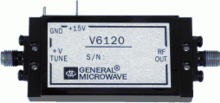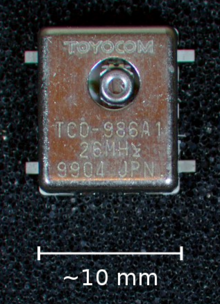Voltage-controlled oscillator

A microwave (12–18 GHz) voltage-controlled oscillator
A voltage-controlled oscillator (VCO) is an electronic oscillator whose oscillation frequency is controlled by a voltage input. The applied input voltage determines the instantaneous oscillation frequency. Consequently, a VCO can be used for frequency modulation (FM) or phase modulation (PM) by applying a modulating signal to the control input. A VCO is also an integral part of a phase-locked loop.
A voltage-to-frequency converter (VFC) is a special type of VCO designed to be very linear in frequency control over a wide range of input control voltages.[1][2][3]
Contents
1 Types of VCO
2 Frequency control
2.1 Phase-domain equations
3 Design and circuits
3.1 Voltage-controlled crystal oscillators
4 Applications
5 See also
6 Notes
7 References
8 External links
Types of VCO
VCOs can be generally categorized into two groups based on the type of waveform produced.
Linear or harmonic oscillators generate a sinusoidal waveform. Harmonic oscillators in electronics usually consist of a resonator with an amplifier that replaces the resonator losses (to prevent the amplitude from decaying) and isolates the resonator from the output (so the load does not affect the resonator). Some examples of harmonic oscillators are LC oscillators and crystal oscillators. In a voltage-controlled oscillator, a voltage input controls the resonant frequency. A varactor diode's capacitance is controlled by the voltage across the diode. Varactor is used to change the capacitance (and hence the frequency) of an LC tank. A varactor can also change loading on a crystal resonator and pull its resonant frequency.
Relaxation oscillators can generate a sawtooth or triangular waveform. They are commonly used in integrated circuits (ICs). They can provide a wide range of operational frequencies with a minimal number of external components.
Frequency control

Schematic of an audio-frequency voltage-controlled oscillator
A voltage-controlled capacitor is one method of making an LC oscillator vary its frequency in response to a control voltage. Any reverse-biased semiconductor diode displays a measure of voltage-dependent capacitance and can be used to change the frequency of an oscillator by varying a control voltage applied to the diode. Special-purpose variable-capacitance varactor diodes are available with well-characterized wide-ranging values of capacitance.
For low-frequency VCOs, other methods of varying the frequency (such as altering the charging rate of a capacitor by means of a voltage controlled current source) are used (see function generator).
The frequency of a ring oscillator is controlled by varying either the supply voltage, the current available to each inverter stage, or the capacitive loading on each stage.
Phase-domain equations
VCOs are used in analog applications such as frequency modulation and frequency-shift keying. The functional relationship between the control voltage and the output frequency for a VCO (especially those used at radio frequency) may not be linear, but over small ranges, the relationship is approximately linear, and linear control theory can be used. A voltage-to-frequency converter (VFC) is a special type of VCO designed to be very linear over a wide range of input voltages.
Modeling for VCOs is often not concerned with the amplitude or shape (sinewave, triangle wave, sawtooth) but rather its instantaneous phase. In effect, the focus is not on the time-domain signal A sin(ωt+θ0) but rather the argument of the sine function (the phase). Consequently, modeling is often done in the phase domain.
The instananeous frequency of a VCO is often modeled as a linear relationship with its instantaneous control voltage. The output phase of the oscillator is the integral of the instantaneous frequency.
f(t)=f0+K0⋅ vin(t)θ(t)=∫−∞tf(τ)dτ{displaystyle {begin{aligned}f(t)&=f_{0}+K_{0}cdot v_{text{in}}(t)\theta (t)&=int _{-infty }^{t}f(tau ),dtau \end{aligned}}}
f(t){displaystyle f(t)}is the instantaneous frequency of the oscillator at time t (not the waveform amplitude)
f0{displaystyle f_{0}}is the quiescent frequency of the oscillator (not the waveform amplitude)
K0{displaystyle K_{0}}is called the oscillator sensitivity, or gain. Its units are hertz per volt.
f(t){displaystyle f(t)}is the VCO's frequency
θ(t){displaystyle theta (t)}is the VCO's output phase
vin(t){displaystyle v_{text{in}}(t)}is the time-domain control input or tuning voltage of the VCO
For analyzing a control system, the Laplace transforms of the above signals are useful.
- F(s)=K0⋅ Vin(s)Θ(s)=F(s)s{displaystyle {begin{aligned}F(s)&=K_{0}cdot V_{text{in}}(s)\Theta (s)&={F(s) over s}\end{aligned}}}
Design and circuits
Tuning range, tuning gain and phase noise are the important characteristics of a VCO. Generally, low phase noise is preferred in a VCO. Tuning gain and noise present in the control signal affect the phase noise; high noise or high tuning gain imply more phase noise. Other important elements that determine the phase noise are sources of flicker noise (1/f noise) in the circuit,[4] the output power level, and the loaded Q factor of the resonator.[5] (see Leeson's equation). The low frequency flicker noise affects the phase noise because the flicker noise is heterodyned to the oscillator output frequency due to the non-linear transfer function of active devices. The effect of flicker noise can be reduced with negative feedback that linearizes the transfer function (for example, emitter degeneration).
Leeson's expression[6] for single-sideband (SSB) phase noise in dBc/Hz (decibels relative to output level per Hertz) is[7]
- L(fm)=10log[12([f02Qlfm]2+1)(fcfm+1)(FkTPs)]{displaystyle Lleft(f_{m}right)=10log left[{frac {1}{2}}left(left[{frac {f_{0}}{2Q_{l}f_{m}}}right]^{2}+1right)left({frac {f_{c}}{f_{m}}}+1right)left({frac {FkT}{P_{s}}}right)right]}
where f0 is the output frequency, Ql is the loaded Q, fm is the offset from the output frequency (Hz), fc is the 1/f corner frequency, F is the noise factor of the amplifier, k is Boltzmann's constant, T is absolute temperature in Kelvins, and Ps is the oscillator output power.
Commonly used VCO circuits are the Clapp and Colpitts oscillators. The more widely used oscillator of the two is Colpitts and these oscillators are very similar in configuration.
VCOs generally have the lowest Q-factor of the used oscillators, and so suffer more jitter than the other types. The jitter can be made low enough for many applications (such as driving an ASIC), in which case VCOs enjoy the advantages of having no off-chip components (expensive) or on-chip inductors (low yields on generic CMOS processes). These oscillators also have larger tuning ranges than the other kinds, which improves yield and is sometimes a feature of the end product (for instance, the dot clock on a graphics card which drives a wide range of monitors).
Voltage-controlled crystal oscillators

27 MHz VCXO clock generator IC (TLSI T73227), used in a DVB-T set-top box.
A clock generator is an oscillator that provides a timing signal to synchronize operations in digital circuits. VCXO clock generators are used in many areas such as digital TV, modems, transmitters and computers. Design parameters for a VCXO clock generator are tuning voltage range, center frequency, frequency tuning range and the timing jitter of the output signal. Jitter is a form of phase noise that must be minimised in applications such as radio receivers, transmitters and measuring equipment.
A voltage-controlled crystal oscillator (VCXO) is used for fine adjustment of the operating frequency. The frequency of a voltage-controlled crystal oscillator can be varied a few tens of parts per million (ppm) over a control voltage range of typically 0 to 3 volts, because the high Q factor of the crystals allows "pulling" over only a small range of frequencies. When a wider selection of clock frequencies is needed the VCXO output can be passed through digital divider circuits to obtain lower frequencies or be fed to a phase-locked loop (PLL). ICs containing both a VCXO (for external crystal) and a PLL are available. A typical application is to provide clock frequencies in a range from 12 kHz to 96 kHz to an audio digital-to-analog converter.
There are two reasons for using a VCXO:
- To adjust the output frequency to match or perhaps be some exact multiple of an accurate external reference.
- Where the oscillator drives equipment that may generate radio-frequency interference, adding a varying voltage to its control input can disperse the interference spectrum to make it less objectionable (see spread spectrum clock).

A 26 MHz TCVCXO
A temperature-compensated VCXO (TCVCXO) incorporates components that partially correct the dependence on temperature of the resonant frequency of the crystal. A smaller range of voltage control then suffices to stabilize the oscillator frequency in applications where temperature varies, such as heat buildup inside a transmitter.
Placing the oscillator in a temperature-controlled "oven" at a constant but higher-than-ambient temperature is another way to stabilize oscillator frequency. High stability crystal oscillator references often place the crystal in an oven and use a voltage input for fine control.[8] The temperature is selected to be the turnover temperature: the temperature where small changes do not affect the resonance. The control voltage can be used to occasionally adjust the reference frequency to a NIST source. Sophisticated designs may also adjust the control voltage over time to compensate for crystal aging.[citation needed]
Applications
VCOs are used in function generators, phase-locked loops including frequency synthesizers used in communication equipment and the production of electronic music, to generate variable tones in synthesizers.
Function generators are low-frequency oscillators which feature multiple waveforms, typically sine, square, and triangle waves. Monolithic function generators are voltage-controlled.
Analog phase-locked loops typically contain VCOs. High-frequency VCOs are usually used in phase-locked loops for radio receivers. Phase noise is the most important specification in this application.[citation needed]
Audio-frequency VCOs are used in analog music synthesizers. For these, sweep range, linearity, and distortion are often the most important specs. Audio-frequency VCOs for use in musical contexts were largely superseded in the 1980s by their digital counterparts, digitally controlled oscillators (DCOs), due to their output stability in the face of temperature changes during operation. Since the 1990s, musical software has become the dominant sound-generating method, though VCOs have regained popularity, often thanks to their natural imperfections.[citation needed]
Voltage-to-frequency converters are voltage-controlled oscillators with a highly linear relation between applied voltage and frequency. They are used to convert a slow analog signal (such as from a temperature transducer) to a digital signal for transmission over a long distance, since the frequency will not drift or be affected by noise. VCOs in this application may have sine or square wave outputs.
See also
Low-frequency oscillation (LFO)- Modular synthesizer
Numerically controlled oscillator (NCO)
Variable-frequency oscillator (VFO)- Variable-gain amplifier
Voltage-controlled filter (VCF)
Notes
References
^ Godse, A.P.; Bakshi, U.A. (2009). Linear Integrated Circuits And Applications. Technical Publications. p. 497. ISBN 8189411306..mw-parser-output cite.citation{font-style:inherit}.mw-parser-output .citation q{quotes:"""""""'""'"}.mw-parser-output .citation .cs1-lock-free a{background:url("//upload.wikimedia.org/wikipedia/commons/thumb/6/65/Lock-green.svg/9px-Lock-green.svg.png")no-repeat;background-position:right .1em center}.mw-parser-output .citation .cs1-lock-limited a,.mw-parser-output .citation .cs1-lock-registration a{background:url("//upload.wikimedia.org/wikipedia/commons/thumb/d/d6/Lock-gray-alt-2.svg/9px-Lock-gray-alt-2.svg.png")no-repeat;background-position:right .1em center}.mw-parser-output .citation .cs1-lock-subscription a{background:url("//upload.wikimedia.org/wikipedia/commons/thumb/a/aa/Lock-red-alt-2.svg/9px-Lock-red-alt-2.svg.png")no-repeat;background-position:right .1em center}.mw-parser-output .cs1-subscription,.mw-parser-output .cs1-registration{color:#555}.mw-parser-output .cs1-subscription span,.mw-parser-output .cs1-registration span{border-bottom:1px dotted;cursor:help}.mw-parser-output .cs1-ws-icon a{background:url("//upload.wikimedia.org/wikipedia/commons/thumb/4/4c/Wikisource-logo.svg/12px-Wikisource-logo.svg.png")no-repeat;background-position:right .1em center}.mw-parser-output code.cs1-code{color:inherit;background:inherit;border:inherit;padding:inherit}.mw-parser-output .cs1-hidden-error{display:none;font-size:100%}.mw-parser-output .cs1-visible-error{font-size:100%}.mw-parser-output .cs1-maint{display:none;color:#33aa33;margin-left:0.3em}.mw-parser-output .cs1-subscription,.mw-parser-output .cs1-registration,.mw-parser-output .cs1-format{font-size:95%}.mw-parser-output .cs1-kern-left,.mw-parser-output .cs1-kern-wl-left{padding-left:0.2em}.mw-parser-output .cs1-kern-right,.mw-parser-output .cs1-kern-wl-right{padding-right:0.2em}
^ Drosg, Manfred; Steurer, Michael Morten (2014). Dealing with Electronics. Walter de Gruyter GmbH. pp. 4.5.3. ISBN 3110385627.
^ Salivahanan, S. (2008). Linear Integrated Circuits. Tata McGraw-Hill Education. p. 515. ISBN 0070648182.
^ Wideband VCO from Herley - General Microwave - "For optimum performance, the active element used is a silicon bipolar transistor. (This is in lieu of GaAs FETs which typically exhibit 10-20 dB poorer phase noise performance)"
^ Rhea, Randall W. (1997), Oscillator Design & Computer Simulation (Second ed.), McGraw-Hill, ISBN 0-07-052415-7
^ Leeson, D. B. (February 1966), "A Simple Model of Feedback Oscillator Noise Spectrum", Proceedings of the IEEE, 54 (2): 329–330, doi:10.1109/PROC.1966.4682
^ Rhea 1997, p. 115
^ For example, an HP/Agilent 10811 reference oscillator
External links
"Design of V.C.O.'s". Ian Purdie's Amateur Radio Tutorial Pages. Retrieved 2018-01-28.
- Designing VCOs and Buffers Using the UPA family of Dual Transistors


![{displaystyle Lleft(f_{m}right)=10log left[{frac {1}{2}}left(left[{frac {f_{0}}{2Q_{l}f_{m}}}right]^{2}+1right)left({frac {f_{c}}{f_{m}}}+1right)left({frac {FkT}{P_{s}}}right)right]}](https://wikimedia.org/api/rest_v1/media/math/render/svg/c29012c8b45e79bc1cc12aeec09e3f498f1ba4c0)